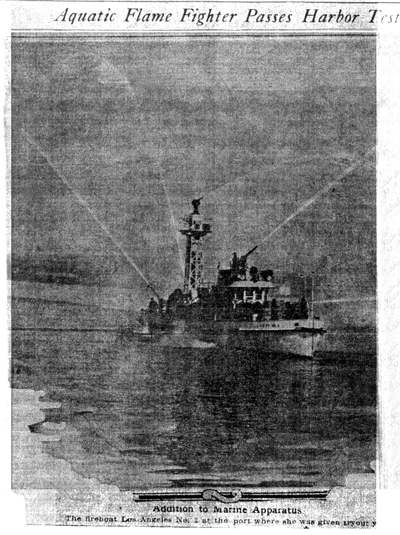
Source: Captain Denny Willahan Collection
Hull Number 47
Fire Boat 2 on the Ways
L.A. Shipyard (later Todd Shipyard)
October 9, 1925
Fire Boat 2 Construction Page
|
Fire Boat No. 2
Los Angeles City No. 2, a state of the art fireboat with many innovations, was built in 1925 at the Los Angeles Shipbuilding and Drydock Corp. (Todd Shipyard), San Pedro. Launched October 20, 1925, the $214,000 fire boat, later renamed Fireboat 2, the Ralph J. Scott, originally was gasoline-powered and rated at 10,200 gpm. |
Just Soldiering
By Stanley E. Halfhill, December 15, 1941
Boat Specifications
By Captain M. P. Allen, Fire Boat No. 2-A,
March 1945
|
|
 |
|
HUNDREDS SPRAYED
BY FIRE BOAT
Streams Wet Spectators
and Three Craft Collide in
Tests at Local Port
Five hundred spectators on a dock and fifteen newspaper and motion-picture cameramen on an observation boat received a wetting, a water taxi had its stern cracked by a stream of water, and the City Council and other official observers narrowly escaped being tipped into the bay in a three-cornered boat collision incidental to the test of the fireboat Los Angeles No. 2 at the harbor yesterday.
The spectators and cameramen were doused when streams from the fireboat went astray. The official observers were shaken up when the fishing boat Perina struck the newspaper tug Bedford, which caromed into the official observation boat Pride.
The fireboat more than satisfied expectations. Pumping with six engines, it threw twenty-nine steams aggregating 12,000 gallons to the minute. A speed test showed more than seventeen miles an hour.
Included in the official observing party were members of the Council, Fire Chief Scott, L. E. Caverly, vice-president of the Los Angeles Shipbuilding and Dry Dock Corporation, designers and builders of the boat; George Codrington, general manager of the Winton Motor Car Company, makers of the engines; Port Manager Spear and Port Warded Perry.
After another week at the shipyard, the boat will take up temporary quarters on the east side of the main channel of the harbor. |
Source: Los Angeles Times, November 6, 1925 |
Fire Station 112
Berth 226-227,
Terminal Island
October 20, 1925 to July 3,1986

Source: Captain Denny Willahan Collection
Circa 1925
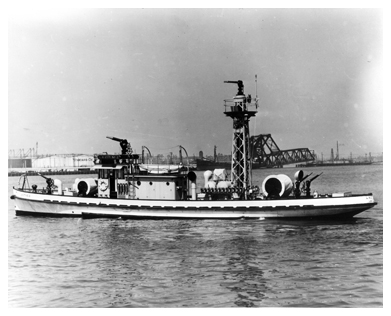
Source: OFFICIAL LAFD PHOTO
Circa 1925
|

Source: OFFICIAL LAFD PHOTO
Circa 1925
|
On May 6, 1924 voters approved a $400,000. bond issue for construction of a fireboat, a station to house it and auxiliary apparatus.
Following completion of L. E. Caverly's designs dated January 31, 1925, a $214,000 contract was awarded to the Los Angeles Shipbuilding and Drydock Corp. (Todd Shipyard) in San Pedro. The contract called for an October 1, 1925, delivery date. At 10:25 a.m., October 25, 1925, Mrs. Ralph J. Scott christened Los Angeles City No. 2 by breaking a bottle of fire-extinguishing foamite across the bow.
Commissioned December 2, 1925 the Los Angeles City No. 2 went into service 25 days later with a crew of 14, including a captain, a pilot, a mate, two engineers and nine firemen.
The triple screw, white-painted fireboat was riveted steel construction. Her length is 99.3", beam 19-feet, depth of hold 9-feet, 152 gross tons and fuel capacity 2156 gal.
Originally the Los Angeles City No. 2 was powered by seven 350-horsepower, 6-cylinder in-line Winton gasoline engines. Three of these Wintons drove the center, port and starboard propellers for a top rated speed of 17 knots (the fastest fireboat afloat). The four other Wintons operated the forward-mounted pumps. Increased pumping capacity resulted from the dual capability of the two wing propulsion engines when they were switched from propulsion to pumping mode. There are six Byron Jackson four-stage centrifugal pumps mounted in pairs forward of the propulsion system. Each is rated at 1700 G.P.M. at 200 psi., for a total output of 10,200 G.P.M.
In 1945 the seven Winton propulsion engines were replaced by Hall Scott engines. Two 625 H.P. V-12 Hall Scott Defenders drive the outboard screws. A 275 H.P. 6-cylinder in-line Hall Scott Invader drives the center screw.
The six Byron Jackson four-stage centrifugal pumps, mounted in pairs forward of the propulsion system are driven as follows:
Pumps No. 1, No. 2, No. 3, and No. 4 are driven by one of the 275 H.P. 6-cylinder in-line Hall Scott Invaders.
Pumps No. 5 and No. 6 are driven by one of the 625 H.P. V-12 Hall Scott Defenders.
Beginning in 1975 the gasoline engines were replaced with diesels and by 1978 two 700 H.P. V-12 Cummins, three 380 H.P. 6 cylinder in-line Cummins and two 525 H.P. V-12 - 2 cycle Detroits power the fireboat.
Fire Boat No. 2 carries breathing apparatus, forcible entry tools, heavy stream appliances, a bank of eighteen 50 lb. CO-2 cylinders (now removed), flood light, smoke ejector equipment, syphon ejectors, drag and grappling hooks, two 3 1/2" Mystery nozzles, and tips up to 6" for the largest deck turret. Four reels carry 4000 feet of various sizes of hose. The boat is equipped with 24 hose outlets (12 port and 12 starboard) and 5 large deck guns. Big Bertha, mounted on the wheelhouse could deliver 10,200-gallons-per-minute via a six-inch nozzle.. The tower turret, believed to be the first, or at least one of the first, fireboat towers in the nation, raises to a height of 42' above the water. |
|
|
|
|
Los Angeles City No. 2 battled its first major fire, March 3, 1926, when the fully-loaded lumber schooner, Sierra, burned at the E. K. Wood Lumber Company wharf, San Pedro. FIREBOATS by Paul Ditzel. |
|
|

SEA-GOING FIREMEN
Los Angeles Times
November 27, 1938

Circa 1930
|
|

Source: OFFICIAL LAFD PHOTO
|
Circa 1930
|

Source: OFFICIAL LAFD PHOTO
|
Circa 1930
|

Source: OFFICIAL LAFD PHOTO
|
Circa 1930
|

Source: OFFICIAL LAFD PHOTO
|
March 23, 1941 |
J.A. Brown,
H. Hollis,
N.O. Chamberlain,
J.R. Lott,
P.J. Larsen,
H.H. Holmer,
G.M. Jorgensen
Captain M.P. Allen,
B.A. Gray,
J.F. Thompson,
L.A. Furu,
H.P. Bates |
|
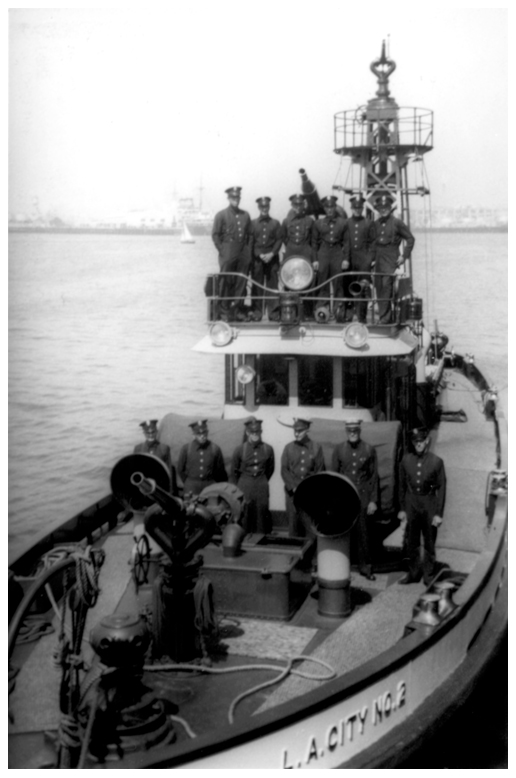
Source: LAFIRE COLLECTION
|
March 23, 1941 |
On the Bridge-- |
G. M. Jorgensen
P. J. Larsen
H. Hollis
J. F. Thompson
H. H. Holmer
H. P. Bates |
Foredeck-- |
N. O. Chamberlain
J. A. Brown
J. R. Lot
L. A. Furu
Captain M. P. Allen
B. A. Gray |
|
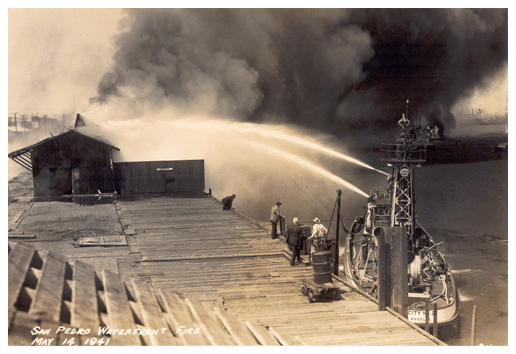
Source: Captain Duane Warth Collection
|
San Pedro Waterfront Fire
May 14, 1941
|
|
Circa 1940
Mounting 5 monitor guns, including a tower gun which could be extended 44 feet above water level, Los Angeles City No. 2 was one of the first large fire boats powered by gasoline. Carrying 2156 gallons of fuel, the fireboat featured a safety system which completely changed the air in the engine room every five minutes as a precaution against leaking gasoline vapors. A further safeguard against below deck fires was a bank of 18 carbon dioxide extinguishing agent cylinders forward of the water tower.
FIREBOATS by Paul Ditzel |
|
|
|
| |
|
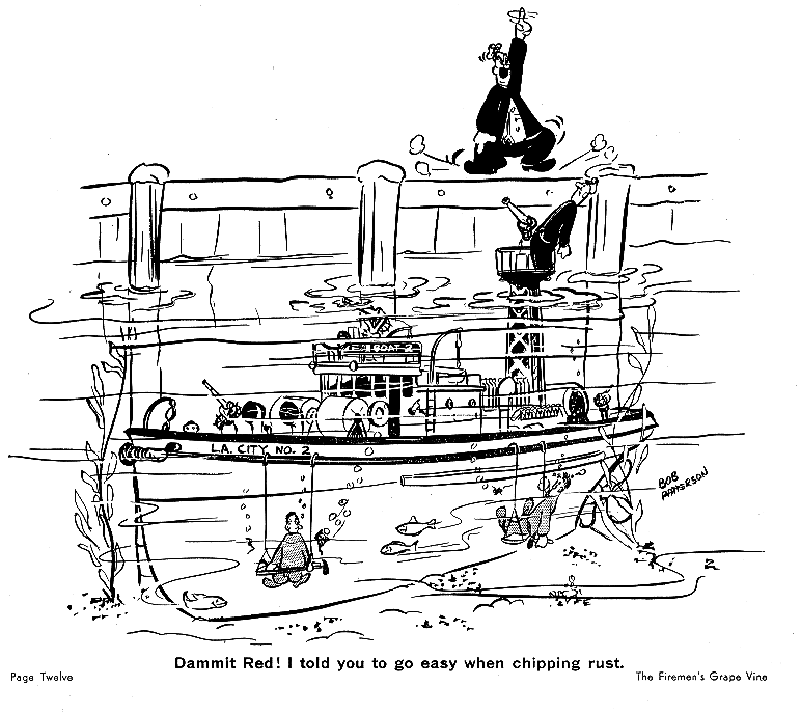
Source: LAFIRE Collection
|
|
Circa 1945
|
Harbor Notes
K.K. Pollard
Fire Boat No. 2 acquired a cat, or should I say a kitten. This little kitten won its way into the hearts of all of the brothers with very little trouble. Its home was on the Boat and it wouldn't come off even for its meals. The nozzle room was chosen by this nautical feline for its boudoir. The nozzle room was also the part of the Boat assigned to McEwen as his cleaning station.
The first morning after the arrival of the kitten on board Mc. inspected the nozzle room and found that the kitten, bless its little heart, had not been house broken. Mc. forthwith captured kitty and used one of the oldest methods know for house breaking cats. The rubbing of the face in the proper place and then tossing the culprit outside. Outside in this particular instance was overboard. The kitten proved to be a good sailor by swimming to the gangway and hoisting itself out of the water, climbed back aboard, wet but wiser. This procedue took place 3 mornings running. On the fouth morning the kitten saw Mc. coming. The little cutie ran for the nozzle roon, rubbed its own face in the prpoer place and then ran and jumped overboard returning in the manner described before. Proving to Mc. that it was a good student even if it wasn't house broke.
The Firemen's Grapevine October 1945 |
|

Photo by Byron S. Crader
Circa 1955
|
|
|
Boat 2
Circa 1955
Berth 226-227, Terminal Island
One of the few covered boathouses ever built for American fireboats, this building, later known as Fire Station 112 became a waterfront landmark until its demolition, July 22, 1986, to make way for a new cargo container complex.
|
|

Photo by Byron S. Crader
Circa 1955
|
On the bow:
Fireman Howard "Lefty" Welker
with Captain Warner L. Lawrence
Circa 1955
|
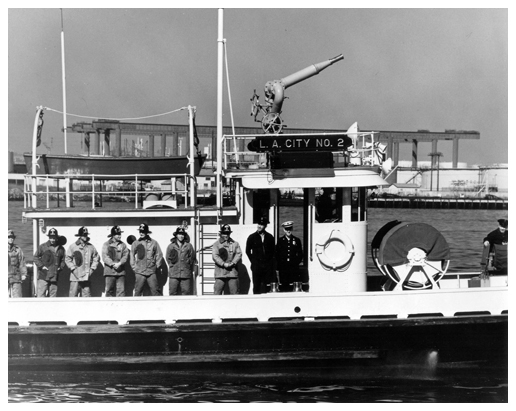 OFFICIAL LAFD PHOTO OFFICIAL LAFD PHOTO
|
1960
Note: Compare the crewmen's Turn-Out Coats with the member's coats shown in the photo above. In 1960 the Department
stiched "Face Piece" pouches on every members Turn-Out coat, the first department to do so.
|

Source: Battalion Chief Larry Schneider
Captain Warner L. Lawrence
Circe 1960
|
 Source: LAFD Photo Album Collection Source: LAFD Photo Album Collection
|
Fireboat 2 at the dedication for the
Vincent Thomas Bridge in San Pedro
September 28, 1963
|
 OFFICIAL LAFD PHOTO OFFICIAL LAFD PHOTO
|
Fireboat 2 attacking simulated dock fire, berth 128, on February 24, 1967. This was part of "Operation West Basin" training program. The shot was taken from the Department helicopter by Bob Praskin. |
|
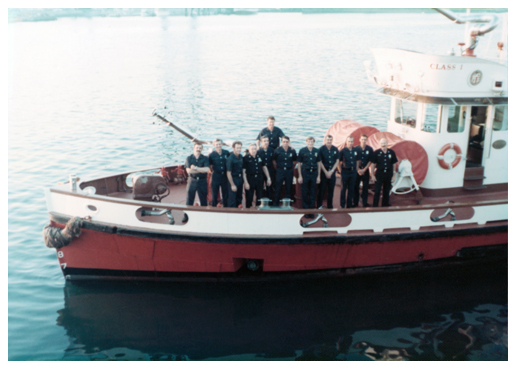 Source: Battalion Chief Larry Schneider Source: Battalion Chief Larry Schneider
|
|
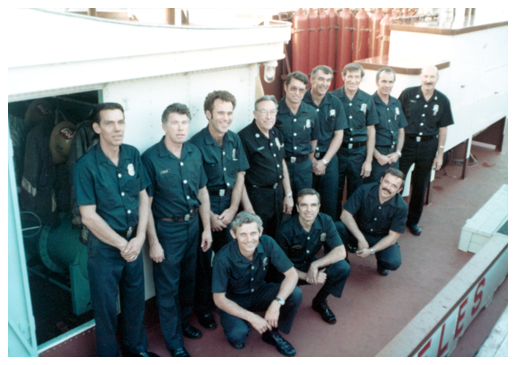 Source: Battalion Chief Larry Schneider Source: Battalion Chief Larry Schneider
|
|

Source: Battalion Chief Larry Schneider
|
|
 Source: Battalion Chief Larry Schneider Source: Battalion Chief Larry Schneider
|
|

The Ralph J. Scott
by Michael Kent, 1983
LISTED ON THE NATIONAL REGISTER OF HISTORIC PLACES, REF. NO. 89001430,
DESIGNATED A NATIONAL HISTORIC LANDMARK, 6/30/89.
National Park Service - Maritime Heritage Program

|
Going
Under
Port's Landmark
Fireboat Station
to Be Torn Down
By JERRY BELCHER,
Times Staff Writer
A Los Angeles land mark—or is it a watermark? —is about to vanish.
Officially, it is Los Angeles Fire Department Station 112. But to the hundreds of firefighters who have served there at one time or another during the past 60 years, it is know simply as Boat 2, an elegantly utilitarian structure on terminal Island where the department has kept its most revered and experienced fireboat out of the weather and in firefight trim since 1926.
The Port of Los Angeles is paying $170,000 to an Anaheim wrecking company to demolish the big, pale-yellow boathouse to make way for the $24.6-million expansion of its overseas terminal containerization facility.
The building is believe to be one of the first, and probably the largest, structure of its kind in the country, said Firefighter Bill Dahlquist, an amateur historian in the esoteric field of fireboat hoses. Not coincidentally, Dahlquist also is pilot of the fireboat Ralph Scott, which has been the sole maritime occupant of the station since it was dedicated six decades ago. |
|
Los Angeles Times
____________________________________________________________
FIREBOAT: Demolition of Station
The sleek red-and-white fireboat, launched in 1925 and modernized three times since then, already has moved to its temporary station, an uncovered moorage at Berth 84 in San Pedro near the Los Angeles Maritime Museum. A new permanent facility is to be built within two or three years.
Somewhat confusingly, the Ralph Scott originally was named L.A. Fireboat No. 2 but was re-christened in 1965 in honor of Fire Chief Ralph J. Scott, who ran the department from 1919 to 1939.
But the 99-foot vessel is better known to firefighters who have served on it over the years as "Scotty" or, more commonly as Boat 2, exactly the same as the old boathouse.
Boat 2, the structure, and Boat 2, the vessel, have played large roles in the history of the Fire Department and the harbor area, said Battalion Chief Larry Schneider, commander of the port fire division.
Schneider, who coincidentally began his firefighting career 32 years ago with an assignment aboard Boat 2, said the boathouse was exceptionally well-designed and built and was by no means outmoded when the decision was made to demolish it.
"I think everyone in the department has always had great respect for the station and the boat." He said. "I know I was always proud of the fact that I'd worked there. It was just a building, not spectacular, just utilitarian. But there was something about the place that everybody loved."
He noted that the boat was ready to go 24 hours a day and regularly churned out of the boathouse within 60 seconds of an alarm. He said the response time at the temporary facility will be about two minutes. The reason, he explained is that the fireboat's crew members are quartered in a temporary modular fire station and must make a 200-foot dash to the tie-up.
'It was just a building, not spectacular,
just utilitarian. But there was something
about the place that everybody loved.'
--Larry Schneider, battalion chief
In the old boathouse, Scotty rested in the barn-like, three-story center section of the 22,500-square-foot building, which was connected to the crew's one-story living quarters by a permanent gangplank. Firefighters were able to dash aboard in seconds.
Dahlquist said that in the 1960's and '70's firefighters made that dash about 150 times a year. Nowadays, because of fewer emergencies, he estimated that the average is about 90 a year.
Some of the alarms of yesteryear were wild ones:
On Oct. 21, 1944, a flash fire spewed flammable liquid across the harbor, engulfing two Navy landing ships, killing nine men and burning to within about 500 feet of the boathouse itself. Other firefighting spectaculars recorded in the annals of Boat 2 include the June 29, 1947, explosion aboard the gasoline tanker Markay, in which 12 men died, and the Dec. 17, 1975 explosion of the oil tanker Sansinena, which killed eight.
Preliminary work on the demolition of the old boathouse began Monday, and the walls are scheduled to come tumbling down July 21.
"We would have liked to have a party (for the boathouse), but we just couldn't find the time for it," Schneider said.
Dahlquist, who has been stationed at the old place for the past 14 years, said simply: "I'll miss it.
|
Los Angeles Times, July 10, 1986
|
|

 November 15, 1940 November 15, 1940
|
 March 1943 March 1943
Fire Boat No. 2, stationed in the harbor, is shown with all nozzles in action in a demonstration of its powerful fire-fighting ability. Firemen of the Harbor Patrol are faced with constant and intense watchfulness during the emergency of war, protecting, as they do, the millions upon millions of dollars worth of property in an area which is the favorite stalking ground of the saboteur. |

July 1947
Fire Boat No. 2 maneuvering along side of Berth 154, the American President Lines pier and warehouse, where it succeeded in stopping the fire at this point. The fire in the background is the burning tanker, the S. S. Markay.
At the time the picture was taken, Boat 2 was using its forward turret, "Big Bertha" and Rail Standees.
|

August 1954
Fire Boat 2 in action during the fire at the San Pedro Marine Terminal of the Tidewater Associated Oil Co.
Photo: By Bullard
Los Angeles' Fire Boat No. 2 cools endangered tanks during a three-alarm fire, June 29, 1954, at the San Pedro Marine Terminal of Tide Water Associated Oil Company. Starting at 6:25 p.m., explosions and fires quickly engulfed 11 of the 17 storage tanks in the facility. Moored beside the boat is Fireboat No. 3.
|

April 1960
Wharf Fire
|
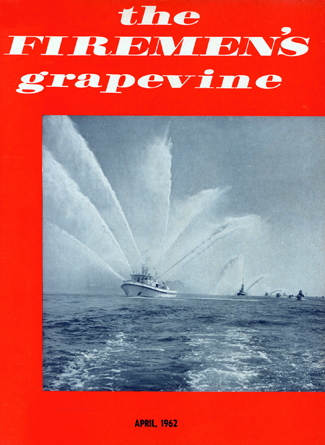
April 1962
L.A.'s brand new fire boat leads her elder sisters, Fire Boat #2 and Fire Boat #1 up the main channel as she arrives in the Port of Los Angeles on February 22, 1962.
|

May 1965
Adorned by beautiful Fire Service Day Queen Margaret Mason (and their respective crews), L.A.F.D.'s Fire Boats 2, 4 and 1 display the gold-lettered names newly affixed to their bows. Photo by Lyons.
|
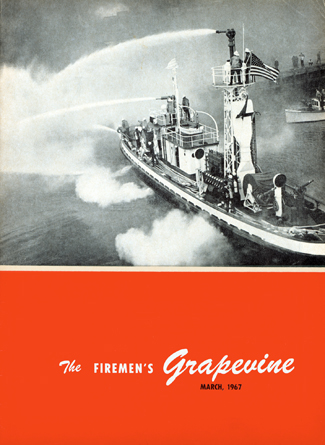
March 1967
Fireboat 2 attacking simulated dock fire, berth 128, on February 24, 1967. This was part of "Operation West Basin" training program. The shot was taken from the Department helicopter by Bob Praskin.
|
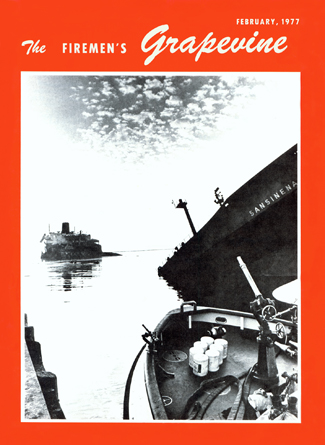 February 1977 February 1977
EXPLOSION IN "PEDRO"
The stern and bow sections of the
70,000 ton oil tanker Sansinena are a grim reminder of the ship's explosion
that rocked San Pedro Harbor and surrounding neighborhoods. Photo by Meadows
|

August 1979
The S. S. Pontos cargo ship
fire, which occurred June 20 at Berth 49 at the harbor.
|
 |
Cover -The Fireman's Grapevine, March 1988
Photo by Mr. Wilton S. Tifft
Note: Fire Boat 2 and Fire Boat 4 (hidden in the spray)
The outstanding cover photograph of two LAFD Fire Boats was taken by Mr. Wilton S. Tifft. Mr. Tifft is a former Fire Chief with the Derrick City Volunteer Fire Department in Pennsylvania and specializes in architectural, corporate, industrial and editorial photography. He has had two books published and is the recipient of many awards in his field.
Poster Available
The cover photo is available at the Relief Association Office in four color poster form for $5.00. Proceeds from the poster sale are contributed to the Widows, Orphans & Disabled Firemen's Fund. |
|
Fire Station 112
Berth 85-86
550 Sampson Way, San Pedro
(Temporary Quarters)
July 3, 1986 to 1995
|

Major Emergency in Harbor
It took 26 Los Angeles City Fire Companies and 5 Fire Boats over two hours to extinguish this difficult fire in the San Pedro area. First arriving fire units reported 300' of Berth 77 on fire and spreading to adjacent boats. Loss estimated to be over $1,500.000 to the wharf and six boats. No injuries were reported and the fire is under investigation.
March, 1988 Photos by Mike Meadows |
|
|
|
Fire Station 112
Berth 86
444 S. Harbor Boulevard, San Pedro
1995 to April 12, 2003

|
|
THE FIREMEN'S GRAPEVINE
March 1998
CFPA Photographer Jeff Miller happened to be flying by in a helicopter and took this great shot (below) of the crew of FireBoat 2 outside their quarters at Fire Station 112.
Miller also captured this interior shot of Fire Station 112.
|
|

THE FIREMEN'S GRAPEVINE
March 1998
|
| |
|






